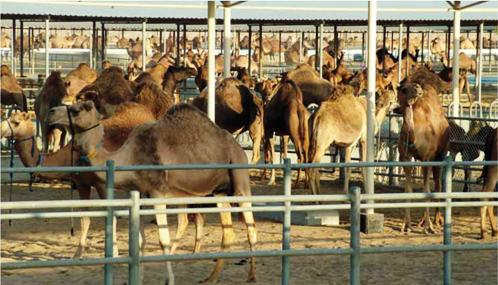Camelids are mammals in the order of the even-toed, hoofed animals (as are pigs and ruminants), but have a separate suborder known as padded foot animals. The Camelidae family consists of three genus: Lama (lama and guanaco) and Vicugna (alpaca and vicuña) considered new-world or South American Camelids and the genus Camelus (dromedary and camel) known as old-world Camelids. It is estimated that there are around 25 million camels in the world, two million of which are Bactrian camels (with two humps) and 23 million dromedary camels (one hump). Bactrians and dromedaries are native to 47 countries in the world. They can be found from the northern part of Africa, through the Middle East, India and Turkey, to Kazakhstan and Russia.
Being a drought adapted animal, camels are mainly found in a desert country. In these areas humans have an important socio-economic bond with camels. They are special companion animals representing wealth (more or less comparable with horses in the Western world) and used for pleasure (racing and beauty contests), production (milk, meat, transportation) and form a base for livelihood in rural areas of poor arid countries for small farmers, nomads and pastoral people.
Although camelids ruminate they are not considered ruminants, but their digestive tract has much in common with the rumen of a cow. “But a camel is not a cow with a hump,” says Peter Nagy, manager of Camelicious, with 2,300 camels on site of the largest dromedary farm in the world in Dubai, UAE. “There is difference in morphology, histology and motility of the fore-stomach. In the stomach three compartments can be recognised (C1, C2 and C3) as is shown in Figure 1. The dorsal part of C1 is stratified epithelium and the ventral part (C2) is made up by glandular mucosa. C3 is a long, intestine-like organ ending in the hind-stomach (H). During motility fluids are pressed in the glandular sac (GS) for potential absorption,” Nagy explains.
New project
Dromedaries have not been considered as valuable milk producing animals in the past – the reason why there is very limited information available on their production potential. At Camelicious, the commercial name for Emirates Industries for Camel Milk and Products – EICMP, the average production is 3,314 kg ± 98 kg per animal. The project started with a pilot in Dubai from 2002-2005 and construction of the farm was realised in 2004/05. Commercial operation took off in February 2006. Owned by Sheikh Mohammed bin Rashid Al Maktoum, ruler of Dubai, who invested US$20 million in the project, it has become the most hi-tech camel milk dairy in the world. The farm currently has around 150 workers including the people working in the processing unit.
Although the farm houses 2,300 camels, only 700 are in milk as a result of the complex and long gestation-lactation period. The length of lactation is 586 days ±10 days, with a peak production of almost 9 kg, but a very good persistence: 50% of maximum production is still present in the 16th month of lactation. Gestation time is 390 days. However, a month after a camel calves, milk production drops considerably, and the camel must be dried off. All in all this results in an inter-calving period of 2.5 years. The first calf is born when the mother is of 4-5 years of age. Apart from this long breeding period there are no historical herd book records of the camels at Camelicious. The project was started in 2006 and most camels were purchased in the region and abroad. This explains that genetic progress is a matter of patience.
“We are at a point where cattle breeding started 50-60 years ago,” says Nagy. “To improve the herd the best producing camels are selected and naturally mated. There are no experiences with artificial insemination in camels and also production data of the bulls is minimal. To speed up the process as much as possible we make use of embryo transplantation.”
Heat detection is complicated as a camel ovulates at the moment of fertilisation (like cats). So the follicles are tested with palpation and ultrasound to see if they are ripe. With embryo transfer about six embryos are harvested with a 65% fertilisation result.
Apart from genetic improvement there is also a need for more knowledge on general and udder health, management (such as presence of calf while milking), milking technology and frequency and data recording methods. For example, camels have ‘a mind of their own’ and need to be trained to walk into the milking parlour. Any change in management makes them hesitate about entering. Milking is done with regular cow milking equipment (a camel has four teats), but is that the right way?
Nutrition trial
Also there is a need for more knowledge on nutrition of the animals. Currently the camels are fed a daily ration of wheat bran and alfalfa hay. Nagy found that feeding more feed does not result in higher milk yields. The camels increase in weight, which has to do with the function of the hump as a storage of energy. Being a ruminating animal a trial was carried out with Lallemand Animal Nutrition investigating the effect of live yeast on rumen micro-flora and production parameters. Live yeast has a direct effect in the (cow)rumen in enhancing anaerobic conditions (oxygen scavenger) and decreases lactic acid accumulation. The indirect effect of live yeast is on raising and stabilising rumen pH. Furthermore it enhances fibre degradation and increases the efficiency of microbial protein production. However, the benefits of live yeast differ according to NDF degradability of the forage. Production parameters of live yeast found in cows are increases in daily yield, feed efficiency and fat and protein yield.
For the trial 90 camels in early lactation were used in June with two dietary treatment groups balanced for production, days in milk and body weight. Both groups were fed 4 kg wheat bran and 6 kg alfalfa hay daily divided in two portions. One group was supplemented with 0.5g/animal of live yeast (i.e. 1×1010 cfu) Saccharomyces cereviciae (CNCM I-1077); Levucell SC 20). The trial lasted for 126 days and milk yield, daily feed intake, body weight, milk composition, udder health and blood haematology and biochemistry data were recorded.
A significant effect of live yeast was found. Milk yield in the live yeast group showed an increase of about 10% compared to the control (7.98 kg vs 7.26 kg, respectively, P<0.001). In time there was also a significant effect on bodyweight in favour of the live yeast group (higher weight). The effect on treatment of raw milk chemical composition was minimal (see Table 1). No differences in milk quality were found. In conclusion it was stated that the use of live yeast:
- increased daily milk production by 10% when given post peak period;
- increased protein yield in milk by 6%;
- optimised protein metabolism (lower blood creatinine and BUN);
- resulted in excellent cost/return ration (1:35), and
- has similar but more pronounced effect than in dairy cows
The economic effect of live yeast in this trial was extraordinary, but mainly due to the price that can be obtained for the camel milk. In Dubai camel milk sells for approx. 10 Dh (€2.07) per litre, where cow milk obtains 1.5 Dh/litre (€0.31).
Camel milk market
In some countries camel milk is marketed after collection and pasteurisation in central processing units and factories (India, Kenya, Mauretania, UAE). The Camelicious project is one step further in tapping the enormous potential of the camel milk market, which is estimated by FAO at Dh35bn (€7.2bn). Earlier efforts to export camel milk to the European market stalled on hygiene requirements, but have come a step closer after samples passed inspection by European regulators. The approval follows last year’s rejection of a bid by the Dubai Central Veterinary Research Laboratory (CVRL), which owns the dairy farm and the brand Camelicious. The country’s animal health system was not found to be rigorous enough. The Dubai food authorities must now comply with European Commission veterinary oversight requirements by September 2013 to obtain a licence. CVRL thinks it can beat that deadline. The challenge is to have the camels give more milk and to increase herds.
“We cannot even cover the demand in the UAE,” said lab director Dr Ully Wernery, according to Dubai’s newspaper, The National. He will travel to Kazakhstan this spring to buy new camel breeding stock. “With 300 to 400 good mothers, we can build on that,” he said. These camels will be put into a breeding programme that aims to quadruple the milking potential of UAE’s camel stock. Camelicious produces about 5,000 litres of milk per day, which is processed on site into consumption milk, yoghurt and milk powder. But this production is hardly enough to cover demand in UAE.
Although Camelicious is not the only producer of camel milk (also Al Ain has a camel herd but has no export intentions) it has a serious program for improvement. If the European market opens for UAE camel milk, demand will increase tenfold. Camel milk has less than half the fat and 40% of the cholesterol of cow’s milk, as well as three times the vitamin C level. It can be digested by people who are lactose intolerant and can ease food allergies. But Emirati camels were always bred for racing and not for milk, so better breeding stock is sought after in other countries where milk production in camels is more pronounced such as Sudan, Saudi Arabia and Kazakhstan. But given the long breeding period it will take time before a serious market is established. Wernery estimates that at least 100,000 camels are needed. “This is a huge number of camels. But Middle Eastern countries with camels should start building farms,” he said.












